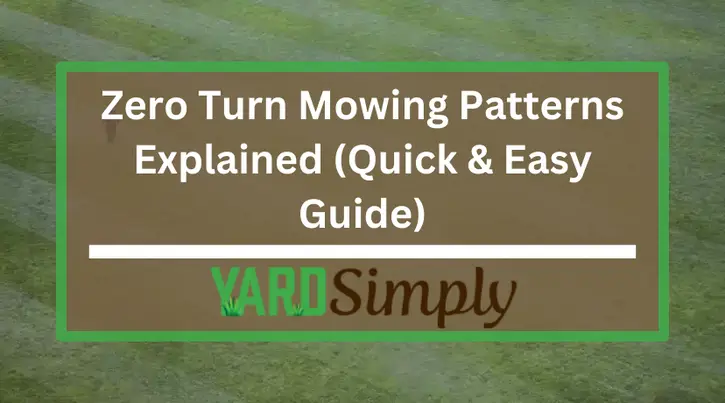With extensive experience in landscaping, I bring a deep understanding of how to masterfully create zero turn mowing patterns that enhance the aesthetic appeal of any lawn.
By utilizing precise techniques and understanding the intricate relationship between grass orientation and light reflection, I guide you on how to achieve that professionally manicured look.
This article is a practical resource for anyone looking to elevate their lawn’s appearance with efficient and effective mowing strategies.
Trust in my expertise to transform your lawn care routine.
Key Takeaways
- Mastering zero turn mowing patterns involves techniques such as creating stripes, curves, and varying lines to enhance the aesthetic appeal of lawns.
- Efficient zero turn mowing patterns include stripes for a professional look, curves for a natural appearance, and checkerboards for a striking effect.
- Well-maintained lawns with artistic mowing patterns can increase property value by up to 15%.
- In my experience, investing time in perfecting mowing patterns is a worthwhile effort that significantly enhances a home’s curb appeal.
Common Lawn Mowing Patterns
As I tackle the topic of zero turn mowing patterns, it’s essential to consider the classic styles that many homeowners and landscapers favor.
Stripes and curves are among the most popular designs, offering a clean and professional appearance.
I’ll also touch on the less common but visually striking patterns like varying lines and concentric circles, which can turn a lawn into a work of art.
- Stripes: Alternating directions with the mower to bend grass blades differently, creating light-reflective stripes.
- Curves: Mowing in smooth, continuous curves for a softer, more natural lawn appearance.
- Varying Lines: Alternating between straight and diagonal lines to add visual interest and encourage healthier grass growth.
- Circle: Creating a spiral pattern starting from the center of the lawn and moving outwards, for a smooth, circular appearance.
- Concentric Circles: Beginning at the center and spiraling outwards with each circle slightly larger than the last, creating a mesmerizing pattern.
- Checkerboard: Mowing in straight lines in one direction and then perpendicular to the first, creating a chessboard effect.
- Diamond or Crisscross: Mowing in diagonal lines in one direction and then intersecting them with another set of diagonal lines in the opposite direction, creating a diamond-shaped pattern.
Stripes
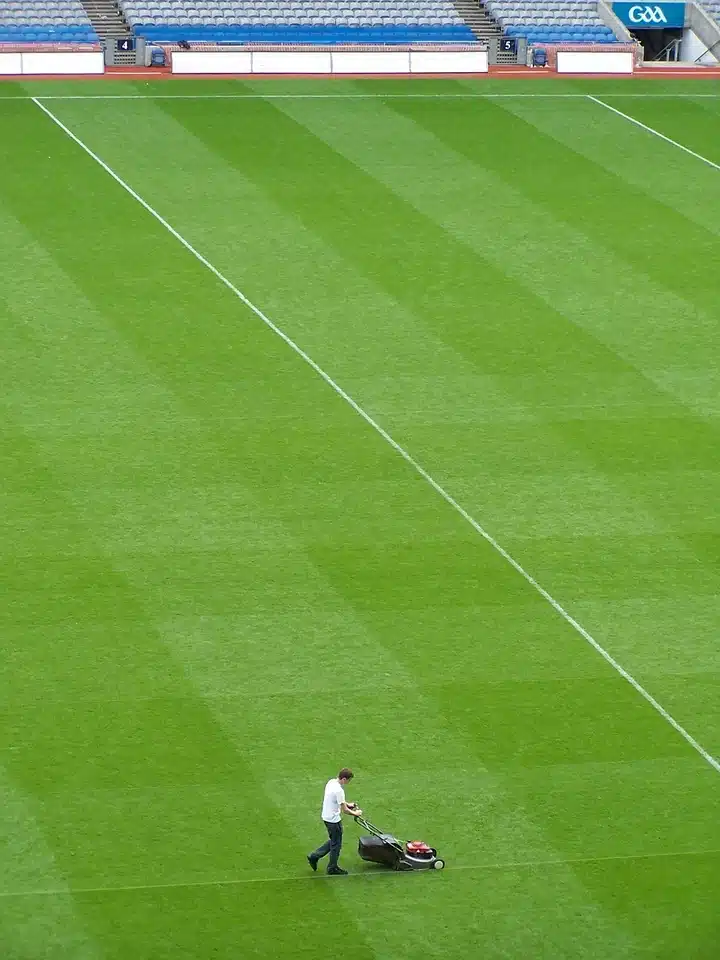
Beyond the basic task of mowing, creating stripes with my lawn mower adds a professional, visually appealing finish to my yard. It’s not just about cutting grass but elevating my lawn’s appearance.
When I glide my zero turn mower over the grass in alternating directions, I bend the blades in different ways, which reflects light variably to create those striking stripes.
Mastering this technique took a bit of practice, but now I can effortlessly maneuver my mower to craft those crisp lines. It’s like I’m painting with the mower, and the lawn is my canvas.
The result? My yard stands out with a clean, manicured look that’s sure to turn heads.
Curves
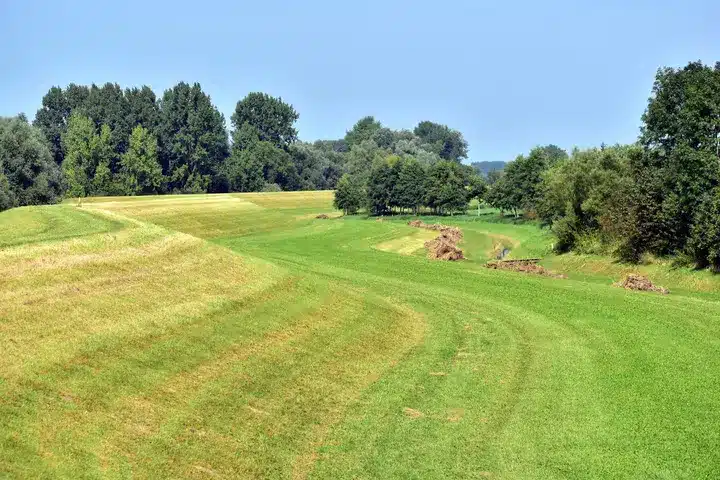
Striping isn’t the only pattern that can enhance my lawn’s aesthetic; mowing in curves offers a softer, more natural look that complements the landscape.
When I’m planning my approach to lawn mowing, I consider how the landscape design might benefit from the flowing lines created by curved patterns.
Using my mower, I can easily execute zero turn mowing patterns which are especially suited for creating smooth, continuous curves without awkward pauses or sharp angles.
I’ve noticed that the curves seem to guide the eye, making the lawn appear more expansive and inviting. Moreover, when I sow grass seeds, I imagine them growing in a way that follows these curves, reinforcing the design even as the grass matures.
Varying Lines
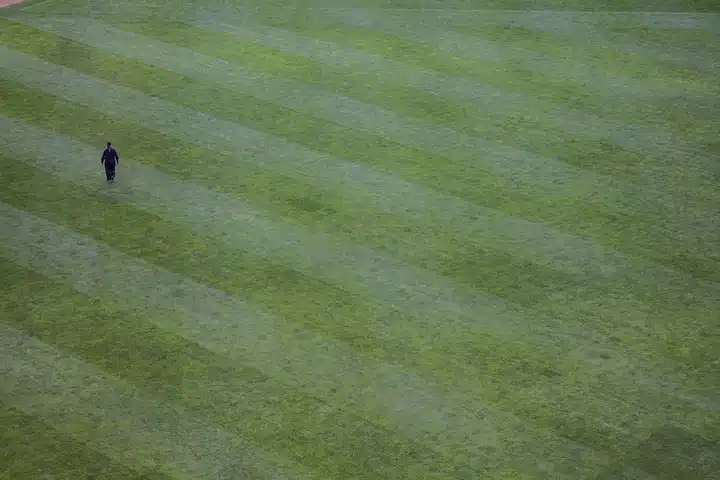
Liquating the direction of my mowing lines adds visual interest and helps prevent grass from leaning in one direction. When I mow the lawn, I love mixing up the patterns; it keeps the garden looking fresh.
One week, I’ll use my garden tractor to create straight lines, and the next, I’ll switch it up to diagonal ones. The diagonal lines especially bring a professional touch to the landscape, making it seem like a baseball field.
I’ve noticed that alternating patterns isn’t just for show—changing the direction I mow in actually encourages healthier grass.
Plus, varying my speed can help avoid rut formation. It’s a practical and visually appealing approach to lawn care that I’ve really come to appreciate.
Circle
Another pattern I often employ with my zero turn mower is the circle pattern, which creates a smooth, spiral look on the lawn. It’s a favorite among lawn care enthusiasts for its pleasing aesthetics.
When I’m mowing, I start at the center of the grassy area and work my way outwards, making sure to overlap each pass slightly. This technique reduces the need for sharp turns that might damage the turf.
The key to mastering zero turn mowing patterns like the circle is maintaining a steady speed and being mindful of the mower’s turning radius.
It’s a bit like gardening; it takes patience and practice, but the end result is a beautifully manicured lawn that stands out in the neighborhood.
Concentric Circle
In my experience with zero turn mowers, transitioning from a single circle to concentric circles elevates the lawn’s visual appeal by adding depth to the pattern.
I’ve found that on a lush Zoysia grass canvas, the results are particularly striking. The dense, fine-bladed turf contrasts sharply against the freshly cut lines, creating a mesmerizing landscape feature that’s sure to turn heads.
Starting at the center, I spiral outward, each turn slightly larger than the last.
This technique isn’t just about looks; it’s practical, especially for larger tractors, as it efficiently covers ground without missing patches. Plus, the consistent overlap ensures an even cut across the whole lawn.
Done right, concentric circles on a well-groomed lawn are a true work of art.
Checkerboard
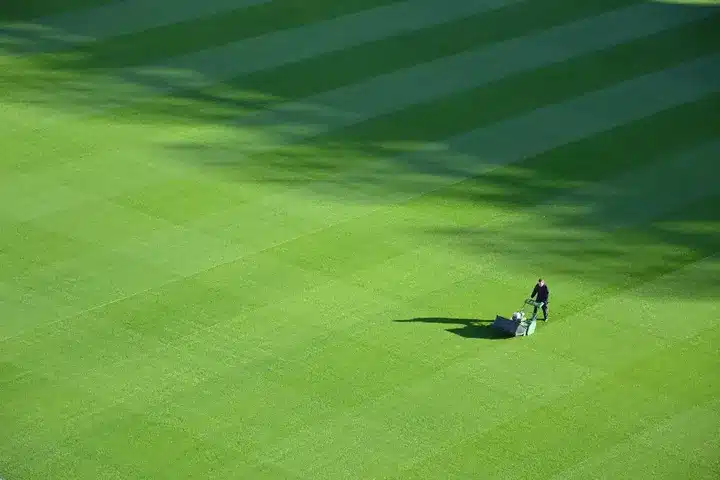
While mastering the concentric circle pattern, I’ve also honed my skills at creating the classic checkerboard pattern, which involves mowing straight lines in alternating directions to achieve a striking, chessboard-like effect on the lawn.
This technique not only enhances the aesthetic appeal of my garden but also showcases the precise capabilities of my zero turn mower.
To execute this, I mow the lawn in parallel lines, then turn my mower 90 degrees and repeat the process, ensuring the grass is bent in opposite directions.
The contrasting light and shadow effects give my lawn that professional, ballpark look. I’ve found that this pattern not only impresses the neighbors but also promotes healthy grass growth by preventing wear patterns from forming.
Diamond or Crisscross
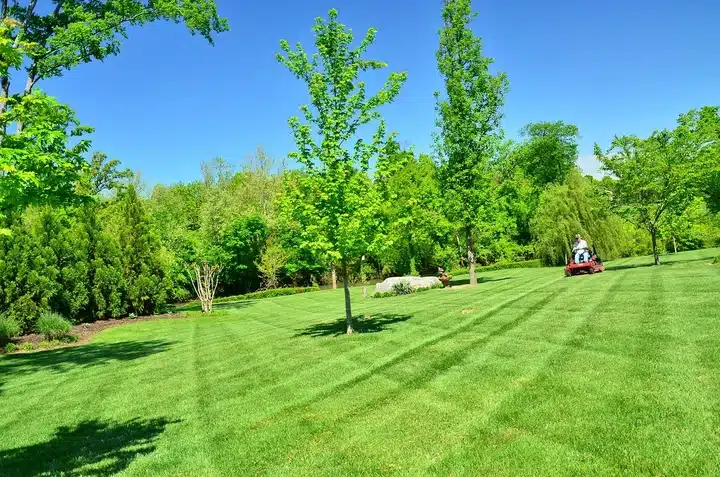
Diamond or crisscross pattern adds an elegant, quilted texture to any lawn by mowing in diagonal lines that intersect. The key is to mow in one diagonal direction across the entire lawn and then mow a perpendicular set of lines to create the diamond effect.
I ensure each pass is at a consistent angle to get that sharp, professional look. It’s not just about the crisscross—it’s how each angle interacts with the grass blades, bending them in different directions to catch the light.
This technique takes patience and precision, but the result is a lawn that stands out with a plush, dimensional appearance. It’s a true testament to the art of lawn care.
Factors Affecting Lawn Mowing Patterns
I consider several key factors when creating lawn mowing patterns with my zero turn mower.
The type of grasses is crucial; for instance, tall fescues have a different texture and growth habit than Bermuda grass, affecting the pattern’s visibility and how often I need to mow.
Soil type also plays a significant role. Sandy soils can drain quickly and may require less frequent mowing compared to clay soils that retain moisture and may lead to faster grass growth.
Light exposure is another factor I can’t ignore. Patterns may be more pronounced on lawns that receive ample sunlight throughout the day, whereas shaded areas mightn’t showcase the designs as clearly.
Furthermore, the climate in my region dictates the mowing schedule and influences the grass’s health and growth rate. Extreme heat or cold can stress the lawn, making it less responsive to pattern mowing.
I always consider these variables to ensure that my patterns enhance the lawn’s natural beauty without causing undue stress to it.
It’s a balancing act between aesthetics and the health of the lawn, but with careful consideration, I can create stunning patterns that make the most of my zero turn mower’s capabilities.
Mowing Patterns How-To
Now, let’s explore how to create eye-catching mowing patterns.
I’ll show you how to use the direction of mowing to play with light and shadow, enhancing the visual impact of your lawn.
We’ll consider the grass type and how alternating the mowing direction creates the striking light and dark contrast that makes patterns pop.
Playing with Light
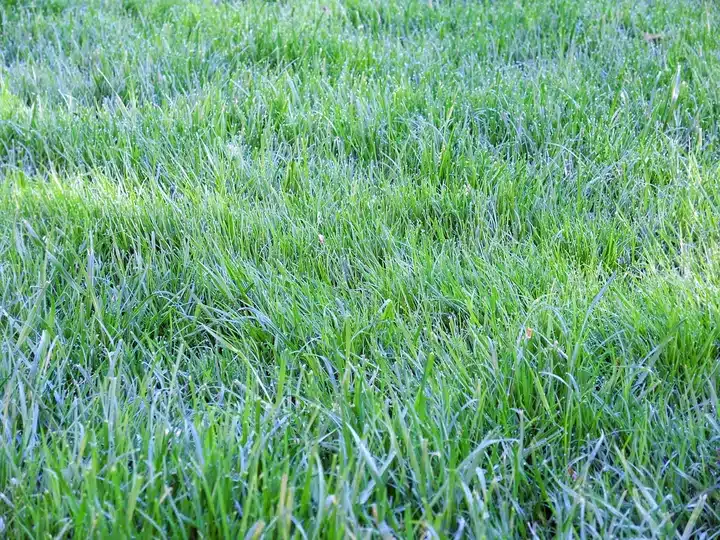
Every time I mow, I manipulate the light’s reflection on my lawn by altering the direction of my zero turn mower, creating vivid patterns.
The secret is in the way the mower’s wheels bend the grass blades in opposite directions.
I’ll start with a basic stripe pattern, aligning each pass parallel to the driveway or sidewalk for a clean, uniform look. It’s like painting with my zero turn – each wheel becomes my brush.
When I crave something fancier, I’ll go for checkerboards or diamonds, careful to make my turns smooth to avoid turf damage.
The key is consistency in speed and direction.
Grass type
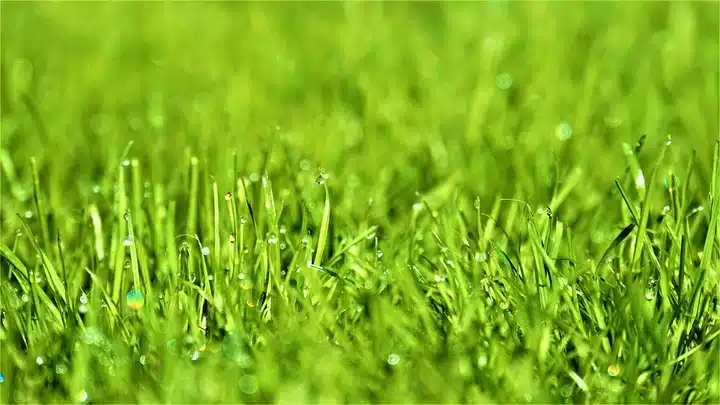
Understanding the type of grass on your lawn is crucial, as it’ll affect how well the patterns hold and how often you’ll need to mow to maintain them.
For instance, fescues, which are cool-season grasses, can create stunning zero turn mowing patterns because of their upright growth habit.
However, they mightn’t be less resilient to frequent mowing than some warm-season grasses.
When I’m planning out my DIY mowing strategy, I consider not only the grass type but also how to deal with weeds that might disrupt my patterns.
Mowing more often can help prevent weeds from establishing and ensure that the patterns I’ve worked hard to create remain visible and crisp.
It’s all about understanding and working with the unique characteristics of my lawn.
Read More: Best Lawn Mowers for St. Augustine Grass
Light Side vs. Dark Side
In crafting my mowing patterns, I’ve learned that the contrast between the light and dark stripes hinges on the direction of the mower’s blades and the way they bend the grass.
The light stripes appear when I mow away from my vantage point; the blades push the grass in that direction, reflecting more sunlight.
Conversely, the dark stripes form as I mow towards myself, with the blades bending the grass towards me, creating a shadowed effect.
I’ve consulted with an arborist and a horticulturist to ensure trees aren’t harmed by my mowing paths. They’ve advised on the optimal grass length and patterns that benefit tree root health.
Also, I always check my mower’s gas level before starting—running out mid-pattern can ruin the whole effect.
Our Verdict
As I reflect on the art of zero turn mowing, I’m reminded of its transformative power over a lawn’s appearance. My journey with mastering these patterns has been rewarding, both aesthetically and regarding lawn health.
From the elegant stripes to the mesmerizing concentric circles, each pattern I’ve created is a testament to the precision and care I put into my lawn care routine.
This isn’t just about mowing; it’s about crafting an outdoor masterpiece that speaks to the effort and pride I invest in my home’s curb appeal.
Whether it’s the sharp lines of a checkerboard or the natural flow of curves, each mowing session is a new opportunity to enhance my lawn’s beauty and showcase my commitment to excellence in landscaping.
Frequently Asked Questions
How does zero turn mowing affect the health of the grass compared to traditional mowing methods?
I’ve found that mowing affects grass health significantly. With my method, the grass stays healthier and grows more evenly than with traditional approaches, since there’s less soil compaction and more precise cutting.
Can zero turn mowers be effectively used on uneven or sloped terrain without causing damage to the lawn?
I’ve found that zero turn mowers can tackle uneven terrain, but they must be used carefully to avoid lawn damage. Proper technique and slower speeds help maintain the grass’s health on slopes.
Are there specific seasons or weather conditions that are best for implementing zero turn mowing patterns?
For optimal mowing, I’ve found that dry seasons are best. I avoid wet conditions to prevent turf damage and ensure clear patterns, although the machine’s capabilities also influence when I can mow effectively.
How should one maintain their zero turn mower to ensure the best quality mowing patterns over time?
To maintain my mower, I regularly check the blades, change the oil, clean the air filter, and ensure the tires are properly inflated to keep it running smoothly for optimal mowing.
What are the environmental impacts of zero turn mowing, and are there more eco-friendly practices that can be incorporated into these patterns?
I’m exploring the environmental effects of lawn mowing and seeking eco-friendly methods to reduce my carbon footprint while keeping my yard well-maintained. I’ll adapt my techniques to be more sustainable.

